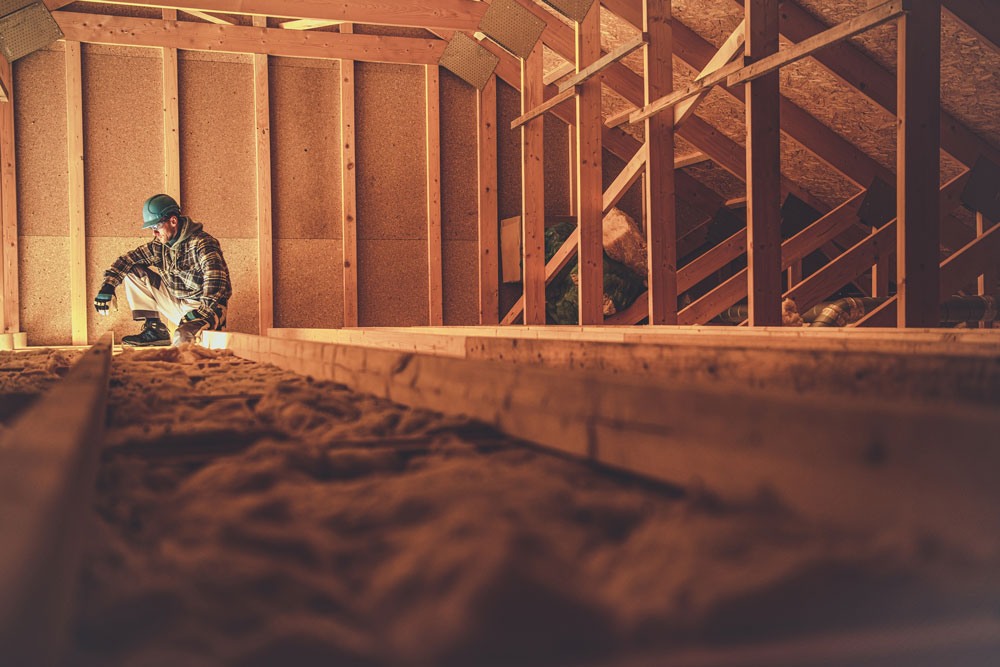What Causes Mould In The Loft?
 CONTENTS
CONTENTS
- What causes mould?
- The signs of mould in your loft
- Is mould in the loft dangerous?
- How to treat mould in the loft
- How to prevent mould in lofts
- Book your mould removal today
One of the most common places for mould to grow unnoticed is in your loft or attic. The warm, poorly ventilated space tends to provide mould with its perfect conditions for growth. If not dealt with immediately, the mould can then spread across the rest of the property.
Here at ICE Cleaning, our mould removal specialists can eliminate all the mould growth in your home as well as determine the root cause of it. We can even provide you with bespoke advisories to help you prevent it returning in the future.
Read on to learn more about what causes mould growth in the loft.
What causes mould?
Mould grows in environments that contain excess moisture. The main causes include damp, high humidity, and condensation. Poor ventilation and airflow can also contribute to mould growth as they enable moist air to build up.
Mould is a common feature in lofts due to their lack of ventilation and is often caused by leaks from the roof. The fungus feeds off organic material, like wood, which lofts tend to contain plenty of, too.
Another key cause is a lack of insulation. When insulation is inadequate or missing altogether, it creates cold spots on surfaces. When warm, moist air comes in contact with them, condensation forms, making the surfaces damp.
Poorly installed insulation can cause condensation as gaps or spaces create uneven temperatures across surfaces, as well.
Loft boarding that has been insulated inadequately can contribute to mould growth. Without proper thermal barrier protection between the boarded area and the roof itself, heat escapes easily, raising humidity levels in the loft.
The type of material used for insulation might even hold onto moisture rather than repelling it, staying damp long enough to allow mould to grow.
The signs of mould in your loft
Musty odours
Mould releases microbial volatile organic compounds which can smell damp, earthy, and musty. The fungus can also smell sour and tangy, or like something that is rotting. The odour is particularly noticeable in enclosed spaces like lofts where ventilation may be limited.
Visible signs of growth
Mould often appears as discolouration or staining on surfaces such as walls, ceilings, and insulation materials within the loft space. While mould can appear in various colours, including black, green, or yellow, you will probably find white mould in the loft.
Mould that is white is in an early development phase and when it matures will become a darker colour.
Water damage
Water stains on ceiling panels or beams suggest moisture ingress which could lead to mould development if not addressed swiftly.
Dampness and condensation
An increase in dampness levels or persistent condensation on surfaces in the loft indicates the presence of excessive moisture which may lead to mould.
Is mould in the loft dangerous?
Firstly, exposure to mould poses significant health risks and is linked to a range of ailments including allergic reactions, respiratory infections, and sick building syndrome.
Individuals with pre-existing health conditions like asthma or allergies, weakened immune systems, and elderly people and young children are more vulnerable to mould exposure. Prolonged exposure could lead to more severe respiratory issues over time.
Some types of mould even produce mycotoxins - toxic chemicals - which are linked to more serious issues.
Mould growth can also cause structural damage as it can eat away at the material it grows on. Wood is particularly susceptible to mould and will start to rot after prolonged growth. This deterioration not only compromises the structural integrity of the property but can even decrease its value.
Any items stored in the loft are vulnerable to damage, too, particularly those made of organic material like wood and certain types of fabric. Mouldy items taken out of the loft and put on display around the home, such as seasonal decorations, can cause the mould growing on them to spread around the property.
How to treat mould in the loft
Attempting to remove mould without proper knowledge of mould remediation or specialist equipment can exacerbate the problem. Disturbing mould colonies can release thousands of spores into the air which you could inhale or allow to spread throughout your home.
Moreover, without addressing the root cause of moisture, any DIY efforts, such as applying bleach or spraying the affected area with vinegar, will just be temporary fixes and the mould will return.
Why professional mould removal is essential
Professionals have access to personal protective equipment (PPE) and follow stringent safety protocols to ensure that mould is removed safely without risking their health.
Specialists will begin with a thorough inspection of your loft space, identifying all areas affected by mould, too. If you remove the mould yourself, you might leave behind hidden mould which will just grow back.
Experts can even address the underlying moisture issues, such as advising on better insulation, or detecting damp and leaks. This will ensure you implement a long-term solution rather than a short-term fix.
Mould cleaners will have specialist equipment for thorough mould removal, as well. They can give you peace of mind they will remove all the mould from the hard surfaces and the air.
There are also lots of challenges associated with removing mould from the loft, the main one being accessibility. The tight spaces make it difficult for people without specialist equipment to effectively reach and treat all the affected areas.
You can learn more about how to remove mould from attic and loft spaces in this blog.
How to prevent mould in lofts
- Install or replace your loft insulation: By installing quality thermal insulation, you significantly reduce the risk of condensation forming on surfaces as it will maintain a more consistent temperature within your loft space.
- Improve air circulation in the loft: Properly installed loft insulation allows for optimal air circulation while preventing excessive moisture accumulation.
- Check for signs of mould regularly: Catching mould early means you can quickly have a small amount removed instead of having a huge mould problem to deal with further down the line.
- Have repairs done immediately: If there is a crack or gap in your roof, or another leak allowing moisture into your loft space, you should have the problem fixed as soon as possible before it leads to a major moisture issue.
Book your mould removal today
Did you know every mould remediation comes with a lifetime guarantee*? In the unlikely event the mould comes back after we treat it, our technicians will return to site and remove it for free.
Get in touch with our team on 0208 066 0360 or via email at enquiries@icecleaning.co.uk to learn more about our mould cleaning services.
ICE Thermal also offers loft insulation installation and can help you deal with the root cause of the mould in your loft as well as mould growth around the rest of your property. To learn more, contact the ICE Thermal team by calling 020 3376 4802 or send an email to [email protected].
*subject to advisories

Speak with me today,
I’m here to help
By asking you a few questions either via phone or email I can immediately provide a realistic estimation of the cost.

Why choose us?
- Cater to a wide variety of cleaning situations
- Nationwide coverage, available 24/7
- Cater to commercial and domestic clients
- Free survey provided prior to quotation
- Emergency response team
- Offer a bespoke service designed to suit all your needs
- All technicians hold professional health and safety qualifications, including BICSc, IOSH, Dewpoint Professional & Safe Contractor
We’re fully accredited
We place best practise, professional expertise and health and safety at the core of our business. We’re fully compliant with all legal obligations. You can view a list of our accreditations below, or visit our Health & Safety page for more information.











-RGB-small.1707319151.jpg)




















